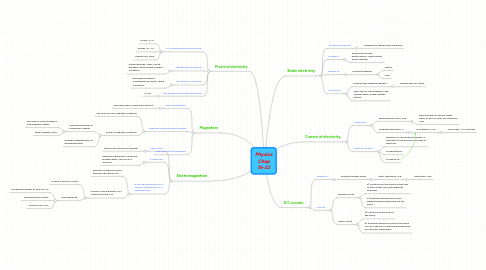
1. Practical electricity
1.1. is concerned with formulae like:
1.1.1. power, P=VI
1.1.2. energy, E= VIT
1.1.3. energy unit, kWh
1.2. requires safety features
1.2.1. using switches, fuses, circuit breakers, earth wireand double insulation.
1.3. has hazards caused by
1.3.1. damaged insulation, overheating of cables, damp conditions
1.4. has heating effects determined by
1.4.1. P=I2R
2. Magnetism
2.1. law of magnetism:
2.1.1. like poles repel, unlike poles attract.
2.2. depends on properties of magnet
2.2.1. not found in non magnetic materials
2.2.2. found in magnetic materials
2.2.2.1. may be permanent or temporary magnet
2.2.2.1.1. are used in circuit breakers and magnetic relays
2.2.2.1.2. have magnetic field
2.2.2.2. undergo magnetisation or demagnetisation
2.3. may be induced magnetism
3. Electromagnetism
3.1. application:
3.1.1. electric bell and circuit breaker
3.2. is shown by:
3.2.1. magnetic field due to current in straight wires, flat coil and solenoid
3.3. is also shown byforce on a current-carrying wire in a magnetic field.
3.3.1. direction is determined by fleming's left hand rule
3.3.2. results in turning effect on a current carrying coil.
3.3.2.1. is used in electric motor
3.3.2.2. is increased by:
3.3.2.2.1. .increasing number of turns in coil
3.3.2.2.2. . increasing the current
3.3.2.2.3. .using an iron core
4. Static electricity
4.1. can be produced by:
4.1.1. charging, by rubbing and induction
4.2. is used in:
4.2.1. printing processes, photocopiers, laser printers, spray painting
4.3. beware of:
4.3.1. potential hazards:
4.3.1.1. sparks
4.3.1.2. fires
4.4. consists of:
4.4.1. positive and negative charges:
4.4.1.1. forming electric fields
4.4.2. obey laws of electrostatics, like charges repel, unlike charges attract.
5. Current of electricity
5.1. is driven by
5.1.1. electromotive force, emf
5.1.1.1. effective emf of cells in series equal to sum of emfs for individual cells
5.1.2. potential difference, V
5.1.2.1. is related to V=IR
5.1.2.1.1. ohm's law, V/I=constant
5.2. flows as current, I
5.2.1. direction of conventional current is opposite to the direction of flows of electrons
5.2.2. is charge/time
5.2.3. is related to:
6. D.C circuits
6.1. applies to:
6.1.1. potential divider using
6.1.1.1. input transducer, e.g.
6.1.1.1.1. thermister, LDR
6.2. may be:
6.2.1. parrallel circuit
6.2.1.1. a) current from the source is the sum of the current from the separate branches
6.2.1.2. b) potential differences across separate parallel branches are the same
6.2.2. series circuit
6.2.2.1. a) current at every point is the same
6.2.2.2. b) potential difference across the whole circuit is the sum of potential differences across each component
